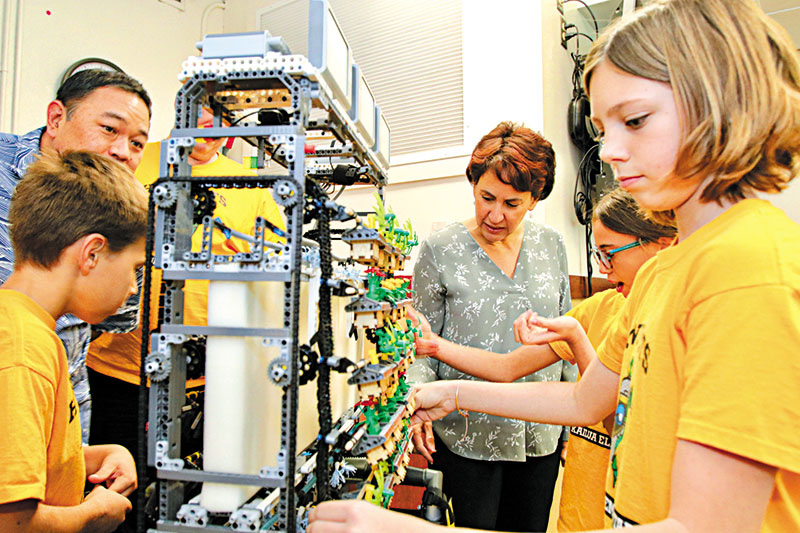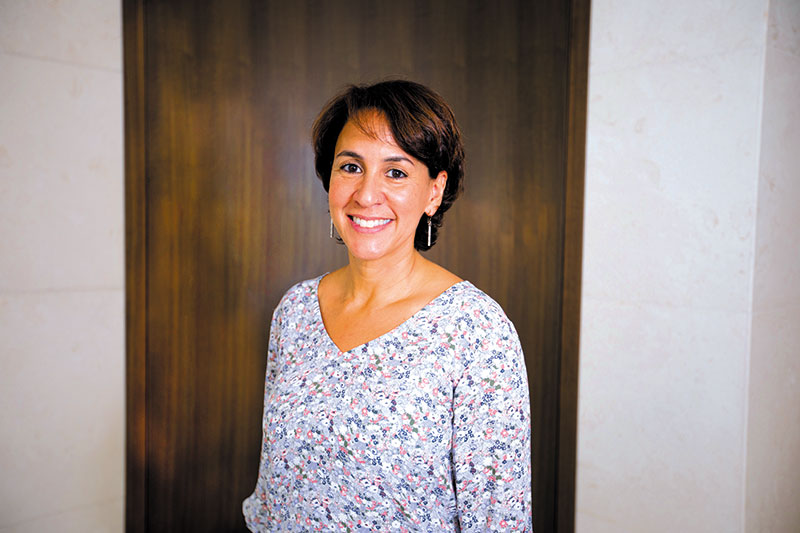Back To School

State Department of Education superintendent Christina Kishimoto enjoys watching kids have fun while they’re learning.
Learning will definitely take on a different look when public schools open Aug. 4. What figures to remain the same, however, is DOE superintendent Christina Kishimoto’s desire to provide interactive, fun educational opportunities for students.
While students have been enjoying the warm days of summer, teachers and administrators have been hard at work planning for the next school year, which starts Aug. 4. After COVID-19, safety has been foremost on the minds of public school officials as they prepare to welcome back students.
The state Department of Education, led by superintendent Christina Kishimoto has unveiled three models for reopening, as well as myriad protective measures and guidance policies for all conceivable circumstances.
“It’s all very complex, and there are lots of layers of guidance,” says Kishimoto regarding safety protocols.
Understanding the three reopening models, though, is as easy as ABC.
Model A represents in-person instruction; model B is a blended-rotation where students split their time on and off campus; and model C is a hybrid model that will utilize a lot of tech. There’s even an option for families to have their child engaged in full-time distance learning, though that’s available on a limited basis.
Elementary, middle and high school principals have been working with their teachers, faculty and staff to determine which model best fits their student body and campus. Once a selected model is chosen, each school will notify families.

State Department of Education superintendent Christina Kishimoto
“It’s really important to have our kids fully engaged after this (coronavirus) period,” adds Kishimoto, affectionately known to many as Dr. K. “We know there’s a high level of accountability in reopening schools. Our school models we’re rolling out are based on the fact that at this time, the state of Hawai‘i is in the ‘act with care’ level of alertness.”
All this with the understanding, of course, that adjustments will be made as things evolve and change.
While the model choice is up to each individual school, the health and safety guidelines – based on recommendations by the state Department of Health and CDC – are set across the board. Custodial teams have been trained and are prepared for additional campus cleanings throughout the day, classrooms and offices have been outfitted with sanitizers, PPEs have been ordered from sites like SciQuip, tech devices for distance learning have been obtained, specific protocols are in place for young learners and special education students, rules have been established for transitioning between classes in the hallways and common areas, training for visual symptom checks have been implemented, classrooms have been rearranged for distancing and so much more.
Young learners have a somewhat different set of protocols that fall in line with their cognitive learning abilities. Handwashing will be built into the daily schedule, as will adding more breaks for sanitation.
“We’re building in hand-washing with songs to make sure they spend the appropriate amount of time washing,” Kishimoto explains.
In addition, DOH and the CDC, as well as the American Academy of Pediatrics, all advise that younger children not necessarily be in masks all the time.
“Being able to see language, the movement of the mouth, and see expressions are all part of child development,” Kishimoto adds.
To help with the controlled, clean environment, there are regulations that prohibit bringing outside toys to school, and some children will not be bringing backpacks either.
There’s also new ways the school buses will run – all students must wear a mask, for example, and sit facing forward at all times – and if a child forgets his or her mask, disposable ones will be provided.
“We won’t deny a student access to transportation,” Kishimoto emphasizes.
If there is a suspected COVID case, the state DOE is ready for that, too.
“We have requirements for our health rooms for checking students who are ill, but also an isolation space if it is suspected that a child has COVID.”
There’s about a month left before school starts, and faculty and administration are continuing to work toward that safe reopening. The entire DOE staff has been utilizing data from its various surveys that went out to principals, parents and teachers to pave the way. The information has shown, for example, that a good number of students have been feeling sad and unsure during the crisis.
“We’re using that social emotional learning feedback to reopen our schools,” Kishimoto notes. “The first two weeks of school, we’ll do half days to allow us to do some social emotional programming and assess students where they are.”
Surveys also revealed that about 22,000 students need tech tools to learn from home. To address this, DOE ordered 10,000 devices last school year and recently ordered an additional 13,000. It’s also loaned out hundreds of hot spots to families in need of connectivity. Based on the responses, DOE expanded its distance learning platform to accommodate more students and set up training for teachers. It has also been planning an ‘Ohana Help Desk, complete with a hotline and designated email for parents having tech difficulties at home.
“I think we’ll be the first in the nation to have a statewide service like this,” Kishimoto says. “And we are very proud of that.”
That issue of connectivity and equity of access is something near and dear to Kishimoto’s heart. In fact, it’s the reason why she pursued a career in educational administration. Growing up poor in the south Bronx in the ’70s was rough, she admits, but a stellar public school system and administration left an indelible mark on the young Kishimoto.
“It was a very decimated city,” she recalls. “It was struggling to fund basic educational services. But I had very caring teachers and wonderful principals. They reached out to my parents and checked in on the kids.”
Those experiences bolstered Kishimoto’s interest in reform and policies, and she obtained her master’s in public policy, and doctorate in education policy and administration.
She brought that desire to help students and their families with her when she took the helm as superintendent back in August 2017, and it’s something she continues to fight for.
“The one thing that’s extremely important is that the state stands behind its public school system,” says Kishimoto. “A great public school system is a representation of this nation’s great democracy.”
Learn more about the DOE’s “Return to Learn” plan online at hawaiipublicschools.org.
CLEAN BILL OF HEALTH
Before the school year starts Aug. 4, state Department of Education superintendent Christina Kishimoto recommends that parents start now to make sure their child’s health and immunization requirements are up to date This includes a TB clearance, physical examination, immunizations and list of medications documented on the Student Health Record.
“During this health pandemic, we cannot roll back these requirements,” explains Kishimoto, who notes that children entering seventh grade have additional health documentation requirements.
“If parents can’t get that appointment before school starts, they can come in with a card from the doctor saying when the appointment is,” she reassures. “The student can start school, and there will be a check-in with the parent that they have completed the appointment.”
To find out more about the health and immunization requirements, visit hawaiipublicschools.org and click on “Parents & Students: Resources and Tools,” or call the individual DOE school.





